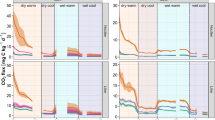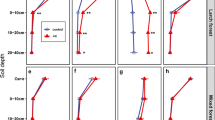Abstract
Nitrogen addition experiments were conducted in three plant communities in a post-mined peatland and on the surrounding original Sphagnum bog in northern Japan to compare the effects of nitrogenous fertilization among the plant communities. Gradients of added nitrogen were prepared by adding nitrogen to 1 m × 1 m plots at rates of 0–36 g/m2/yr. These different levels of nitrogen addition were applied to four sites representing a vegetation development chronosequence: bare ground (BG), a Rhynchospora alba sedgeland (RA), a Moliniopsis japonica grassland (MJ) and the original Sphagnum bog (SS). Vegetation was monitored in each plot for three years, and the groundwater level and nitrogen concentration in peat-pore water were monitored in each plot. The nitrogen concentration in peat-pore water increased with increasing nitrogen addition on BG, but was constantly low at the vegetated sites, suggesting the occurrence of nutrient uptake by plants. Species richness decreased as a result of nitrogen addition at the SS site, where plant cover was high. The aboveground biomass of the two common grasses M. japonica and Phragmites communis was not influenced by nitrogen addition in the post-mined peatland. Grasses and sedges, which produce large underground organs, showed increased biomass as a result of nitrogen addition in the SS plot whereas Sphagnum declined. Additionally, forbs declined in the SS plot with increasing nitrogen, most likely due to competition with the increased populations of grasses. Therefore, nitrogen enrichment can promote the dominance grasses, leading to a decrease in mosses and forbs.







Similar content being viewed by others
References
Aerts R, Wallen B, Malmer N (1992) Growth-limiting nutrients in Sphagnum-dominated bogs subject to low and high atmospheric nitrogen supply. J Ecol 80:131–140
Alvarez M, Tron GF, Mauchamp A (2005) Sexual versus asexual colonization by Phragmites australis: 25-year reed dynamics in a Mediterranean marsh, southern France. Wetlands 25:639–647
Andersen R, Francez AJ, Rochefort L (2006) The physicochemical and microbiological status of a restored bog in Quebec: Identification of relevant criteria to monitor success. Soil Biol Biochem 38:1375–1387
Baer SG, Blair JM, Collins SL, Knapp AK (2004) Plant community responses to resource availability and heterogeneity during restoration. Oecologia 139:617–629
Bart D, Hartman JM (2002) Environmental constraints on early establishment of Phragmites australis in salt marshes. Wetlands 22:201–213
Bedford BL, Walbridge MR, Aldous A (1999) Patterns in nutrient availability and plant diversity of temperate North American Wetlands. Ecology 80:2151–2169
Berendse F, van Breemen N, Rydin H, Buttler A, Heijmans M, Hoosbeek MR, Lee JA, Mitchell E, Saarinen T, Vasander H, Wallén B (2001) Raised atmospheric CO2 levels and increased N deposition cause shifts in plant species composition and production in Sphagnum bogs. Global Change Biol 7:591–598
Bowman WD, Theodose TA, Fisk MC (1995) Physiological and production responses of plant growth forms to increases in limiting resources in alpine tundra: implications for differential community response to environmental change. Oecologia 101:217–227
Breeuwer A, Heijmans MMPD, Robroek BJM, Berendse F (2008) The effect of temperature on growth and competition between Sphagnum species. Oecologia 156:155–167
Chapin III FS, Bret-Harte MS, Hobbie SE, Zhong H (1996) Plant functional types as predictors of transient responses of arctic vegetation to global change. J Veg Sci 7:347–358
Cobbaert D, Rochefort L, Price JS (2004) Experimental restoration of a fen plant community after peat mining. Appl Veg Sci 7:209–220
Daha E, Hadač E (1941) Strandgesellschaften der Insel Ostoy im Oslofjord. Nytt Mag Naturvidensk 82:251–312
Dorrepaal E, Cornelissen JHC, Aerts R, Wallen B and van Logtestijn RSP (2005) Are growth forms consistent predictors of leaf letter quality and decomposability across peatlands along a latitudeinal gradient? J Ecol 93:817–828
Dupre C, Stevens CJ, Ranke T, Bleeker A, Peppler-Lisbach C, Gowing DJG, Dise NB, Dorland E, Bobbink R, Diekmann M (2010) Changes in species richness and composition in European acidic grasslands over the past 70 years: the contribution of cumulative atmospheric nitrogen deposition. Global Change Biol 16:344–357
Eckstein RL, Donath TW (2005) Interactions between litter and water availability affect seedling emergence in four familial pairs of floodplain species. J Ecol 93:807–816
Egawa C, Koyama A, Tsuyuzaki S (2009) Relationships between the developments of seedbank, standing vegetation and litter in a post-mined peatland. Pl Ecol 203:217–228
Fujita Y, Robroek BJM, de Ruiter PC, Heil GW, Wassen MJ (2010) Increased N affects P uptake of eight grassland species: the role of root surface phosphatase activity. Oikos 119:1665–1673
Green EK, Galatowitsch SM (2002) Effects of Phalaris arundinacea and nitrate-N addition on the establishment of wetland plant communities. J Appl Ecol 39:134–144
Güsewell S, Koerselman W, Verhoeven JTA (2002) Time-dependent effects of fertilization on plant biomass in floating fens. J Veg Sci 13:705–718
Güsewell S (2005) High nitrogen: phosphorus ratios reduce nutrient retention and second-year growth of wetland sedges. New Phytol 166:537–550
Heijmans MM, Klees H, de Visser W, Berendse F (2002) Response of a Sphagnum bog plant community to elevated CO2 and N supply. Pl Ecol 162:123–134
Hotes S, Poschlod P, Takahashi H, Grootjans AP, Adema E (2004) Effects of tephra deposition on mire vegetation: a field experiment in Hokkaido, Japan. J Ecol 92:624–634
Iwatsuki Y, Mizutani M (1972) Colored illustrations of bryophytes of Japan. Hoikusya Publishing, Osaka
Jauhiainen J, Wallén B, Malmer N (1998) Potential NH4 + and NO3 − uptake in seven Sphagnum species. New Phytol 138:287–293
Japan Meteorological Agency (2007) Available at: http://www.data.jma.go.jp/obd/stats/etrn/index.php
Keddy PA (2000) Wetland ecology principles and conservation. Cambridge University Press, Cambridge
Keeney DR, Nelson DW (1982) Methods of soil analysis. Part. 2. Chemical and microbiological properties, 2nd ed. In Page AL, Miller RH, Keeney DR (eds) Nitrogen-inorganic forms. American Society of Agronomy and Soil Science of America, Madison, pp 643–698
Ketcheson SJ, Price JS (2011) The impact of peatland restoration on the site hydrology of an abandoned block-cut bog. Wetlands 31:1263–1274
Koyama A, Tsuyuzaki S (2010) Effects of sedge and cottongrass tussocks on plant establishment patterns in a post-mined peatland, northern Japan. Wetlands Ecol Managem 18:135–148
Kool A, Heijmans MMPD (2009) Dwarf shrubs are stronger competitors than graminoid species at high nutrient supply in peat bogs. Pl Ecol 204:125–134
Kuhry P, Vitt DH (1996) Fossil carbon/nitrogen ratios as a measure of peat decomposition. Ecology 77:271–275
Lamers LPM, Bobbink R, Roelofs JGM (2000) Natural nitrogen filter fails in polluted raised bogs. Global Change Biol 6:583–586
Larcher W (2003) Physiological plant ecology. Ed. 4. Springer-Verlag, Berlin, Heidelberg, New York
Limpens J, Berendse F (2003) Growth reduction of Sphagnum magellanicum subjected to high nitrogen deposition: the role of amino acid nitrogen concentration. Oecologia 135:339–345
Limpens J, Berendse F, Klees H (2003) N deposition affects N availability in interstitial water, growth of Sphagnum and invasion of vascular plants in bog vegetation. New Phytol 157:339–347
Limpens J, Granath G, Gunnarsson U, Aerts R, Bayley S, Bragazza L, Bubier J, Buttler A, van den Berg LJL, Francez AJ, Gerdol R, Grosvernier P, Heijmans MMPD, Hoosbeek MR, Hotes S, Ilomets M, Leith I, Mitchell EAD, Moore T, Nilsson MB, Nordbakken JF, Rochefort L, Rydin H, Sheppard LJ, Thormann M, Wiedermann MM, Williams BL, Xu B (2011) Climatic modifiers of the response to nitrogen deposition in peat-forming Sphagnum mosses: a meta-analysis. New Phytol 191:496–507
Mack MC, Schuur EAG, Bret-Harte MS, Shaver GR, Chapin III FS (2004) Ecosystem carbon storage in arctic Tundra reduced by long-term nutrient fertilization. Nature 431:440–443
Makipaa R (1999) Response patterns of Vaccinium myrtillus and V. vitis-idaea along nutrient gradients in boreal forest. J Veg Sci 10:17–26
Nishimura A, Tsuyuzaki S, Haraguchi A (2009) A chronosequence approach fro detecting revegetation patterns after Sphagnum-peat mining, northern Japan. Ecol Res 24:237–246
Ohlson M, Malmer N (1990) Total nutrient accumulation and seasonal variation in resource allocation in the bog plant Rhynchospora alba. Oikos 58:100–108
Ohwi J (1975) Flora of Japan (revised edn). Shibundo, Tokyo
Øien DI (2004) Nutrient limitation in boreal rich-fen vegetation: A fertilization experiment. Appl Veg Sci 7:119–132
Price JS, Whitehead GS (2001) Developing hydrologic thresholds for Sphagnum recolonization on an abandoned cutover bog. Wetlands 21:32–40
R Core Team (2014) R: A Language and environment for statistical computing. R Foundation for Statistical Computing, Vienna, Available at http://www.R-project.org
Rickey M, Anderson RC (2004) Effects of nitrogen addition on the invasive grass Phragmites australis and a native competitor Spartina pectinata. J Appl Ecol 41:888–896
Schrijver AD, De Frenne P, Ampoorter E, Van Nevel L, Demey A, Wuyts K, Verheyen K (2011) Cumulative nitrogen input drives species loss in terrestrial ecosystems. Global Ecol Biogeogr 20:803–816
Stevens CJ, Dise NB, Mountford JO, Gowing DJ (2004) Impact of nitrogen deposition on the species richness of grasslands. Science 303:876–1879
Tachibana H, Hotta S, Minamide M, Saito H, Kawamura T (1996) Chemical characteristics of ground water and surface water in Sarobetsu Mire and its surrounding area. J Water Environm 19:910–921
Tagawa M (1983) Colored illustrations of the Japanese pteridophyta. Hoikusya Publishing, Osaka
Tomassen HM, Smolders AJP, Lamers LPM, Roelofs JGM (2003) Stimulated growth of Betula pubescens and Molinia caerulea on ombrotrophic bogs: role of high levels of atmospheric nitrogen deposition. J Ecol 91:357–370
Tomassen HBM, Smolders AJP, Limpens J, Lamers LPM, Roelofs JGM (2004a) Expansion of invasive species on ombrotrophic bog: desiccation or high N deposition? J Appl Ecol 41:139–150
Tomassen HBM, Smolders AJP, Lamers LPM, Roelofs JGM (2004b) Development of floating rafts after the rewetting of cut-over bogs: the importance of peat quality. Biogeochemistry 71:69–87
Van Duren IC, Pegtel DM (2000) Nutrient limitations in wet, drained and rewetted fen meadow: evaluation of methods and results. Pl & Soil 220:35–47
Wilson SD, Tilman D (2002) Quadratic variation in old-field species richness along gradients of disturbance and nitrogen. Ecology 83:492–504
Wind-Mulder HL, Vitt DH (2000) Comparisons of water peat chemistries of a post-harvested and undisturbed peatland with relevance to restoration. Wetlands 20:616–628
Zoltai SC, Vitt DH (1995) Canadian wetlands: Environmental gradients and classification. Vegetatio 118:131–13
Acknowledgements
Special thanks are due to I. Kudo, who carried out the chemical analyses. We also thank S. Ishibashi, A. Koyama and all members of the Regional Ecosystem Lab, GSEES, HU, for various assistance. Last but not least, we thank H. Nogawa and all staff members of the Ministry of the Environment of Japan and staff members of the Toyotomi Town Office for granting us the necessary research permission.
Author information
Authors and Affiliations
Corresponding author
Additional information
Plant nomenclature
Ohwi (1975), Tagawa (1983), Iwatsuki and Mizutani (1972)
Rights and permissions
About this article
Cite this article
Nishimura, A., Tsuyuzaki, S. Plant responses to nitrogen fertilization differ between post-mined and original peatlands. Folia Geobot 50, 107–121 (2015). https://doi.org/10.1007/s12224-015-9203-2
Received:
Accepted:
Published:
Issue Date:
DOI: https://doi.org/10.1007/s12224-015-9203-2




